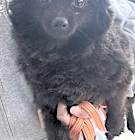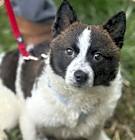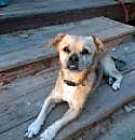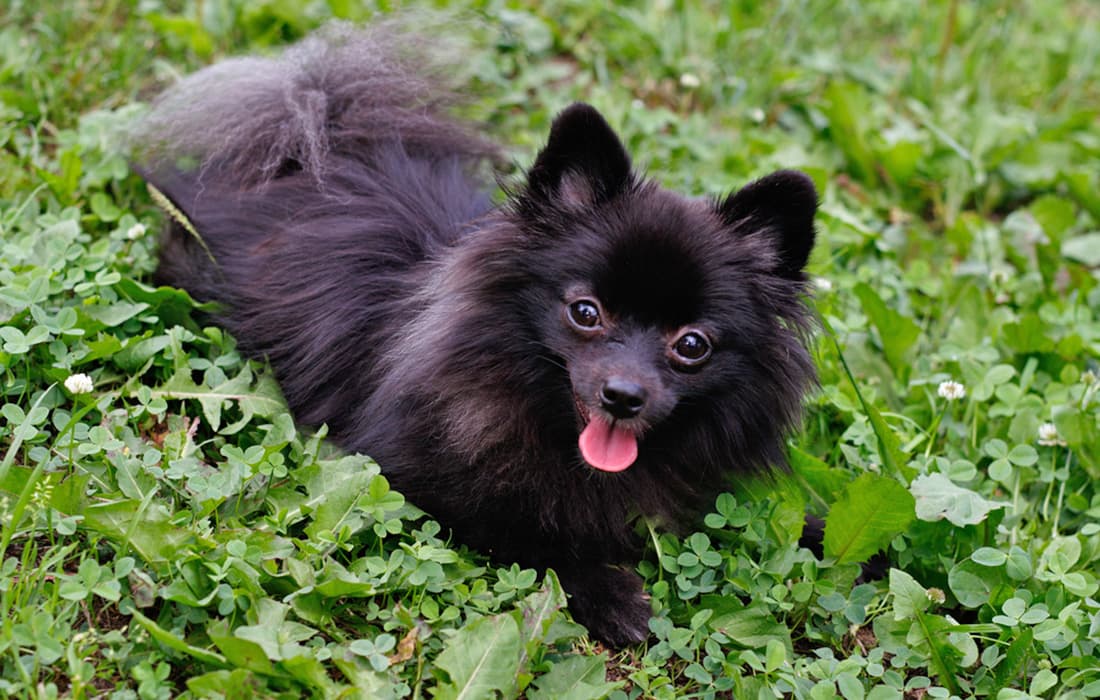Pomeranians weigh between three to seven pounds and stand about six to seven inches tall at the shoulder. These dogs are classified as a toy breed and tend to maintain their small size throughout their lives, with no significant increase in height after reaching maturity.
Pomeranian
Breed Type: Toy
Common nicknames: Pom, Loulou
Coat: Double
Hypoallergenic: No, they will likely trigger allergies.
Temperament: Lively, affectionate, vocal, affectionate
Life expectancy: 12-16 years
Color & patterns:

Meet the Pomeranian (or “Pom” for short), a little ball of fluff known for their plush coats, adorable faces, and stealing hearts left and right. These pups may be small — they are a toy breed and typically weigh between three and seven pounds — but they’re mighty. They have spunky attitudes and are great at learning new tricks and cues, making them popular in the world of canine agility. They’re also fiercely loyal to their humans. Pomeranians can be a little spicy but are usually sweet: These dogs can also be affectionate lap-dogs. If you’re looking for a small, peppy BFF, the Pomeranian might just be the perfect match.
Pomeranian characteristics
Learn about about Pomeranian basics like their fur colors, shedding levels, how much grooming they need, and other Pomeranian facts.
Average height
7-12 inches (17.8-30.5cm)
Average weight
3-10 pounds (1.4-4.5 kg)
Average lifespan
12-16 years
Exercise needs
Grooming needs
Full-grown size
Good with cats
Good with kids
Training aptitude
What colors do Pomeranians come in?
Pomeranians come in solid colors like black, white, cream, orange, and red, alongside various combinations such as sable, brindle, merle, and parti-color. The AKC recognizes over 20 standard colors and markings for this breed, offering potential pet parents a broad spectrum of choices in coat appearance.
Does a Pomeranian have hair or fur?
Pomeranians have fur, not hair. This is actually a common misconception. While their coat might look like hair, it is actually a double-layered fur coat. Unlike some other breeds, a Pomeranian’s fur grows continuously and needs regular grooming to prevent matting.
What is a teddy bear Pomeranian?
A teddy bear Pomeranian is a Pom with the looks of a teddy bear. These dogs often have a more closely trimmed haircut than one given to standard Pomeranians to give them a more teddy bear-like appearance. Grooming a Pom like this accentuates their small, compact appearance and rounded faces. The teddy bear Pomeranian isn’t a distinct or official breed variation.
Can you shave a Pomeranian?
No, you shouldn’t shave a Pomeranian because their double-layered coat serves as insulation against both cold and heat. Shaving can disrupt their natural coat growth and cause various coat-related issues. While a trim or grooming to maintain their coat’s health and cleanliness is fine, shaving isn't recommended, as it can interfere with their coat’s natural protective properties. Consult a professional groomer or veterinarian for the best grooming practices for your Pomeranian.
Does a Pomeranian shed?
Yes, Pomeranians shed. They have a double coat with a soft, dense undercoat and a longer, harsh-textured outer coat. Shedding is a regular occurrence for this breed, with increased shedding during shedding seasons, typically in the spring and fall. Regular brushing can help minimize loose hair, but shedding is still a typical characteristic of this breed.
What does a Pomeranian look like?
The Pomeranian is a small dog with a sturdy, compact body and a dense double coat that comes in a variety of colors. They have a fox-like face with small, erect ears. Pomeranians often have a bright, alert expression, characterized by their dark, almond-shaped eyes. This breed’s most distinctive feature is its thick, profuse coat that stands out in a lion-like mane around the neck and chest. The tail is set high, carried flat on the back, and is heavily plumed.
When is a Pomeranian full grown?
Pomeranians are usually full grown by one year old. While their height typically stabilizes at this point, some Poms might continue to develop their final coat and fur characteristics until they are approximately 18 months old. By this time, they’ve generally reached their full adult size and weight.
How long does a Pomeranian live?
Pomeranians typically live between 12 to 16 years. Factors such as genetics, diet, exercise, and routine veterinary care play vital roles in the longevity and well-being of these dogs. Maintaining their health through regular check-ups and providing proper nutrition and exercise can help extend the life of a Pomeranian.
What is a Pomeranian?
The Pomeranian is a small and lively toy breed known for its fluffy double coat, fox-like expression, and big personality. Their size and cheerful nature make them ideal for city living and family companionship, while their alertness and loyalty endear them to pet parents seeking a canine companion.
Are Pomeranians hypoallergenic?
No, Pomeranians are not hypoallergenic. While no dog breed is completely hypoallergenic, Pomeranians are not among the breeds typically recommended for allergy sufferers. Their double coat sheds consistently, which can spread dander, the primary allergen, throughout the environment.
Pomeranian history
Learn about where this Pomeranian came from!
How many types of Pomeranians are there?
There is only one official type of Pomeranian recognized by the American Kennel Club (AKC). Some breeders, however, have developed different types of Pomeranian, including the fox face, teddy face, miniature, baby doll, and throwback.
What was the Pomeranian bred for?
The Pomeranian was originally bred for companionship and as a pet to royalty and nobility. This breed’s ancestors were much larger and used for work, such as herding and pulling sleds, particularly in the region of Pomerania in Central Europe. But over time, the Pomeranian’s size reduced significantly, as they were bred to become more of a companion animal and a beloved family pet due to its charming disposition.
Where did the Pomeranian originate?
The Pomeranian dog breed originates from the Pomerania region, an area located between Poland and Germany. Named after the region, the breed has its roots in the spitz-type dogs and was initially larger, serving in various working roles such as herding and pulling sleds. Over time, these dogs were selectively bred to become smaller and were favored by nobility, notably by Queen Victoria, which contributed to their popularity and the refinement of their distinct appearance and personality traits.
Pomeranian temperament
Learn about about the Pomeranian temperament and how well they fit into your lifestyle, home environment, and family.
Are Pomeranians good with kids?
Yes, Pomeranians can be good with kids. They make affectionate and playful companions for considerate children who understand how to interact gently with a small dog. In fact, teaching children how to properly approach and handle dogs of all breeds is crucial to ensure positive experiences for both the dog and the child.
However, due to their small size and occasionally sensitive nature, Pomeranians might not be the best match for very young kids who could unintentionally mishandle them, leading to potential stress or accidents.
As with any breed, it’s also important for pet parents to teach their dogs how to gently interact with children and supervise all interactions with them to make sure everyone stays safe.
Is a Pomeranian a good family dog?
Yes, Pomeranians can be good family dogs. They can make them a great playmate for older children, although pet parents should always supervise interactions between any dogs and kids to ensure that both the dog and the child understand how to behave appropriately around each other.
Remember that these spunky pups need regular exercise and mental stimulation to stay happy, much like anyone else in the family.
Are Pomeranians easy to train?
Yes, Pomeranians are easy to train if you use the right approach. They are intelligent and quick learners, but they can also be willful and easily distracted, making consistent training a necessity.
Training any dog takes substantial time and effort, regardless of breed. Using positive reinforcement methods and starting training and socialization early can help them understand commands and desired behaviors. Patience, repetition, and rewards are essential when training Pomeranians.
Do Pomeranians bark a lot?
Yes, Pomeranians bark a lot. Their alert and active nature may lead them to vocalize to express excitement, alert their pet parents of visitors, or as a response to unfamiliar or alarming noises. Early training and socialization can help moderate their barking tendencies and channel their energy positively.
Can a Pomeranian be a service dog?
Yes, a Pomeranian can be a service dog. While some Pomeranians have been successful in providing emotional support, their smaller size might be a challenge for specific assistance roles. They can be exceptional therapy animals offering companionship and comfort due to their affectionate and adaptable nature.
How smart is a Pomeranian?
Pomeranians are reasonably intelligent dogs. While they might not be top performers in obedience trials like some breeds, they have a high level of intelligence and adaptability. Their cleverness is often displayed through their curious and playful nature, making them quick learners.
Is a Pomeranian a good dog?
Yes, Pomeranians are good dogs. They’re admired for their lively and affectionate nature, and their small size makes them great choices for apartment living. Their loyalty, intelligence, and enthusiasm make them good pets, provided they receive appropriate training, care, and socialization. Pomeranians are known for being smart, curious, energetic, feisty, and bold and make wonderful family pets.
Are Pomeranians good with cats?
Yes, Pomeranians can be good with cats if they are introduced gradually in a controlled environment. Their playful and friendly nature often helps them bond well with feline companions, but it’s essential to monitor their initial interactions to ensure both the Pomeranian and the cat feel secure and comfortable with each other.
Pomeranian health
Learn about about the Pomeranian health outlook and what diseases they may be prone to at various stages of their life.
How often should you groom a Pomeranian?
You should groom a Pomeranian two to three times a week to help prevent matting and keep their fur in good condition. During shedding seasons, typically occurring twice a year, more frequent brushing and regular baths can help manage loose fur and minimize shedding. You should also trim their nails and brush their teeth regularly to ensure overall health and hygiene.
Do Pomeranians have health problems?
Yes, Pomeranians have health problems they’re more prone to, including:
Legg-Calve-Perthes: This is a condition that causes the head of the femur (located in a dog’s hind leg) to spontaneously degenerate. Over time, this will lead to erosion of the hip joint and arthritis. A Pomeranian suffering from Legg-Calve-Perthes may become lame, limp while walking, or experience pain when moving the hip joint. Surgery is the most effective treatment for the disorder.
Patellar luxation: Patellar luxation, also known as slipped kneecaps, is a common problem in many dog breeds. It occurs when slight abnormalities cause the knee joint to slide in and out of place, leading to pain and occasional lameness. Surgical treatment is available for severe cases.
Alopecia X: There is a very rare genetic disorder that has led to some Pomeranians having Alopecia X, which turns their skin black and causes their hair to fall out.
Others: Pomeranians are also prone to trachea collapse, allergies, epilepsy, eye problems such as cataracts and dry eyes, gum disease, and early tooth loss. Special attention should be made to their oral, ear, and eye health to avoid these issues.
Popular Pomeranian mixes
A few common Pomeranian mixes include:
Pomchi (Pomeranian + Chihuahua)
Dameranian (Pomeranian + Dachshund)
Pomsky (Pomeranian + Husky)
Pomapoo (Pomeranian + Poodle)
Shiranian (Pomeranian + Shih Tzu)

Find Pomeranian puppies near you
Adopting a Pomeranian
Learn about acquiring a Pomeranian - the pros and cons of adopting versus going through a breeder, and associated costs.

Jessie
Pomeranian
Male, adult
Sunbury, OH
Good with dogs
Good with cats
House-trained
Spayed or Neutered
Shots are up-to-date

Vivian-PMRT
Pomeranian
Female, adult
Pataskala, OH
Good with dogs
Good with cats
Spayed or Neutered
Shots are up-to-date

Edna
Pomeranian
Female, adult
Ashville, OH
Good with dogs
Not good with cats
Spayed or Neutered

Rueben
Pomeranian
Male, adult
Ashville, OH
Not good with dogs
Not good with cats
Spayed or Neutered

Scout
Pomeranian Siberian Husky
Male, young
Ashville, OH
Good with dogs
Not good with cats
House-trained
Spayed or Neutered

Jonah
Pomeranian
Male, adult
Ashville, OH
Not good with dogs
Not good with cats
Spayed or Neutered

stella
Pomeranian Pug
Male, 9 yrs 2 mos
Lancaster, OH
Not good with dogs
Not good with cats
Spayed or Neutered

Jessie
Pomeranian
Male, adult
Sunbury, OH
Good with dogs
Good with cats
House-trained
Spayed or Neutered
Shots are up-to-date

Vivian-PMRT
Pomeranian
Female, adult
Pataskala, OH
Good with dogs
Good with cats
Spayed or Neutered
Shots are up-to-date

Edna
Pomeranian
Female, adult
Ashville, OH
Good with dogs
Not good with cats
Spayed or Neutered

Rueben
Pomeranian
Male, adult
Ashville, OH
Not good with dogs
Not good with cats
Spayed or Neutered

Scout
Pomeranian Siberian Husky
Male, young
Ashville, OH
Good with dogs
Not good with cats
House-trained
Spayed or Neutered

Jonah
Pomeranian
Male, adult
Ashville, OH
Not good with dogs
Not good with cats
Spayed or Neutered








